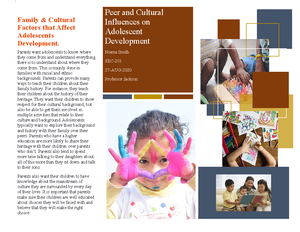- Information
- AI Chat
Was this document helpful?
Healthy Education Development on Adolescents
Course: Early Adolescent and Adolescent Psychology (SEC-201)
130 Documents
Students shared 130 documents in this course
University: Grand Canyon University
Was this document helpful?

Danielle de Souza
03/31/2019
SEC – 201
Prof. Debra Lynch
Healthy Education Development on Adolescents
Now a days, it is hard to keep adolescents motivated and focused on important subjects.
Technology has made this new generation very dependent on their self-image online, they think
they might need to look or dress a certain way in order to fit in; and all these things clutter their
minds, and it leaves no space for learning. But technology will not always be the enemy, it can
be used positively and promote a healthy learning environment for students to learn. Below are
just a few proven examples on how an educator can successfully engage with their students to
promote well-being.
Providing a healthy learning environment for the students is important, but that starts
with the educators themselves. Teachers can take a few cognitive measures when preparing for
class. Cognitive strategies are quite advantageous when cooperating with learning problems.
Cognitive strategies give a structure to realizing when an assignment can't be finished through
steps. For instance, calculations in arithmetic give a progression of ventures to solve a problem.
The basic cognitive strategies educators can adhere are evaluating the content they will cover;
this seems obvious at first glance, but many teachers just gloss over the subject instead of
thinking it through in order to create a productive lecture. Once evaluated, educators need to
determine the accurate approaches for the students’ success. Lastly, educators may teach with













